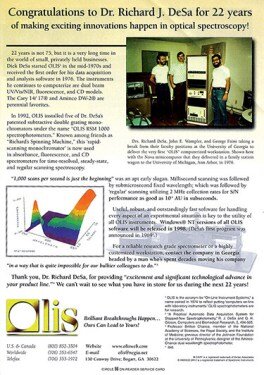What Does Spectrophotometers Do?
What Does Spectrophotometers Do?
Blog Article
What Does Circular Dichroism Mean?
Table of ContentsThe Main Principles Of Circular Dichroism The smart Trick of Circularly Polarized Luminescence That Nobody is DiscussingThe smart Trick of Circularly Polarized Luminescence That Nobody is Talking AboutWhat Does Circular Dichroism Mean?The Greatest Guide To Circular Dichroism

Spectrophotometry is a tool that hinges on the quantitative analysis of molecules depending on how much light is absorbed by colored compounds.
The Single Strategy To Use For Circular Dichroism
A spectrophotometer is commonly utilized for the measurement of transmittance or reflectance of options, transparent or nontransparent solids, such as sleek glass, or gases. Although many biochemicals are colored, as in, they soak up visible light and therefore can be determined by colorimetric procedures, even colorless biochemicals can frequently be transformed to colored substances suitable for chromogenic color-forming reactions to yield substances suitable for colorimetric analysis.: 65 Nevertheless, they can also be developed to measure the diffusivity on any of the listed light varieties that typically cover around 2002500 nm using different controls and calibrations.
An example of an experiment in which spectrophotometry is used is the decision of the stability constant of a solution. A specific chemical response within a service may take place in a forward and reverse instructions, where reactants form items and items break down into reactants. At some time, this chemical response will reach a point of balance called a balance point.
Circular Dichroism Things To Know Before You Get This
The amount of light that passes through the solution is indicative of the concentration of specific chemicals that do not permit light to go through. The absorption of light is due to the interaction of light with the electronic and vibrational modes of particles. Each kind of molecule has an individual set of energy levels associated with the makeup of its chemical bonds and nuclei and therefore will soak up light of specific wavelengths, or energies, leading to distinct spectral residential or commercial properties.
They are widely used in lots of industries including semiconductors, laser and optical production, printing and forensic examination, as well as in labs for the study of chemical substances. Spectrophotometry is frequently utilized in measurements of enzyme activities, determinations of protein concentrations, decisions of enzymatic kinetic constants, and measurements of ligand binding reactions.: 65 Eventually, a spectrophotometer is able to identify, depending on the control or calibration, what substances are present in a target and exactly how much through computations of observed wavelengths.
Created by Arnold O. Beckman in 1940 [], the spectrophotometer was produced with the help of his coworkers at his business National Technical Laboratories established in 1935 which would become Beckman Instrument Company and ultimately Beckman Coulter. This would come as a solution to the formerly developed spectrophotometers which were unable to absorb the ultraviolet correctly.
The smart Trick of Spectrophotometers That Nobody is Talking About
It would be found that this did not provide acceptable results, for that reason in Model B, there was a shift from a glass to a quartz prism which permitted much better absorbance results - circularly polarized luminescence (https://www.slideshare.net/julieanndesalorenz30). From there, Design C was born with a modification to the wavelength resolution which wound up having three systems of it produced
It was produced from 1941 to 1976 where the rate for it in check here 1941 was US$723 (far-UV accessories were an alternative at extra cost). In the words of Nobel chemistry laureate Bruce Merrifield, it was "probably the most important instrument ever established towards the improvement of bioscience." Once it became discontinued in 1976, Hewlett-Packard developed the first commercially available diode-array spectrophotometer in 1979 referred to as the HP 8450A. It irradiates the sample with polychromatic light which the sample takes in depending on its residential or commercial properties. Then it is sent back by grating the photodiode range which identifies the wavelength region of the spectrum. Since then, the production and application of spectrophotometry devices has increased tremendously and has actually turned into one of the most ingenious instruments of our time.

Circularly Polarized Luminescence Things To Know Before You Buy
The grating can either be movable or fixed.
In such systems, the grating is repaired and the intensity of each wavelength of light is measured by a various detector in the variety. When making transmission measurements, the spectrophotometer quantitatively compares the fraction of light that passes through a referral solution and a test option, then electronically compares the intensities of the two signals and calculates the percentage of transmission of the sample compared to the recommendation standard.

Report this page